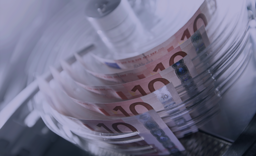
50 Years of Eurocheque: the history of a great European
From paper cheques and debit cards to contactless payment: The eurocheque system, which officially celebrates its 50th birthday on 1 May 2019, has made a rapid career. What nobody suspected at the time: The foundation stone for today's modern payment methods was laid. Giesecke+Devrient (G+D) takes a look back at the eventful history of a great European, which has had a decisive influence on the Munich-based company.
The 15 x 8.5 centimetre paper was invented at the end of the 1960s as a cashless and cross-border means of payment. In 2019 the Euroscheck or eurocheque, as it is officially called, will celebrate its 50th birthday: The official starting signal was given on 1 May 1969. Travellers no longer had to pack Schilling, Franc, Lira or Peseta, but could cash the cheques in many European countries. At its peak in 1988, an estimated 950 million eurocheques were issued in the respective European countries in addition to the 50 million paper cross-border payment orders. The total amount of all cheques this year was over 75 billion euros.
Caught up by the digitalization
In the early years, laminated security paper and later a piece of plastic, the ec-card, were used to guarantee authenticity. It initially served as a pure payment guarantee, but laid the foundation for electronic payment. As more and more ATMs became available in the late 1970s, a debit function was added to the card. From now on money could be withdrawn by means of the black magnetic strip. From 1991, it was possible to pay nationwide by card and PIN in supermarkets, gas stations and other shops - the electronic cash debit card system was born. In 1995 the prepaid function "money card" followed. The electronic wallet can be used to pay small amounts without a PIN or signature. In recent years, mobile payment methods have become increasingly popular, and in many shops it is now possible to pay with a smartphone or even a smart watch.
For the cheque itself, electronic cash was the beginning of the end. On 1 January 2002, the ec cheque lost its international guarantee function; since then, payment orders issued on a eurocheque form have merely been normal cheques under the respective national laws. However, the name EC card remained for the time being - as did the logo with the blue "e" and red "c", which had decorated checks and cards since the late 1960s.
The very beginning
Giesecke+Devrient was involved in the development and establishment of the first European cross-border payment system right from the start. Siegfried Otto, long-time CEO of Giesecke+Devrient, and Dr. Eckart van Hooven, Member of the Management Board of Deutsche Bank and then Chairman of the Supervisory Board of Giesecke+Devrient, came up with the idea of introducing a cheque guarantee card, thus increasing the acceptance of cheques among retailers and trade and making them more popular with consumers. The Munich-based company was not only represented in the key German and European committees, many of the technical foundations of cashless payment transactions as well as numerous other innovations relating to security and mobility can be traced back to Giesecke+Devrient. Since the end of the 1960s, the traditional company has been involved in the development of ATMs, multifunctional bankcards and chip cards. Today, Giesecke+Devrient is a leader in physical (banknotes), electronic (card solutions) and mobile (apps) payment methods.
"By setting up the eurocheque system, Giesecke+Devrient began one of the most responsible and interesting tasks in its long history," explains Astrid Wolff, Head of Corporate Heritage at Giesecke+Devrient. "Together with representatives of banks and savings banks, we have developed the idea for a uniform and cross-border payment system. With the order to set up and produce the eurocheque system, the starting signal has been given for the numerous innovations of the coming decades. Today, cashless payment, limitless communication and secure identification have become part of everyday life. We supply the right solutions and will continue to develop new technologies for the mobile world to make people's everyday lives more comfortable and safer. “
Important key data:
- In May 1968, representatives of banking associations from 15 European countries met in Frankfurt under the chairmanship of Dr. Eckart van Hooven, Member of the Management Board of Deutsche Bank and Chairman of the Supervisory Board of Giesecke+Devrient, with the aim of creating a uniform and cross-border cheque system.
- It became more concrete at a second conference in Paris in October 1968: The cheque system was given the name eurocheque, symbolized by an EC logo. And the eurocheque card was introduced as a guarantee card for cheques.
- From 1 May 1969, the eurocheque system was introduced in 15 countries and experienced an unbroken triumphal march. Very quickly, most European countries joined, followed by countries of the Middle East and North Africa.
- From 1972, a joint cheque certificate and a uniform cheque guarantee card were issued. The elimination of the printed currency symbol created the conditions for cash payments in the local currency and cashless payment at retail and service outlets.
- In 1972 there were already 5.5 million eurocheque cards in circulation in the Federal Republic of Germany, and eleven million cards in 1978.
- In the 1980s, the EC cheque lost importance due to the rapidly increasing use and distribution of GAAs (cash dispensers).
- At the end of the 1990s, the card system was the largest payment system in Europe with almost 60 million users.
- In 1999 it was decided that the EC cheque would lose its international guarantee function on 1 January 2002.
- Since 2007, the bank or savings bank card has been called Girocard in Germany.
- In 2017, the nationwide rollout of contactless payment with the Girocard began.
About Giesecke+Devrient
Giesecke+Devrient (G+D) is a global security technology group headquartered in Munich, Germany. Innovations from G+D make the lives of billions of people in the digital and physical world more secure. With its products and solutions, G+D is one of the market and technology leaders in the areas of payment, connectivity, identities and digital security.
Founded in 1852, the company generated sales of 2.25 billion Euros in the 2018 fiscal year with 11,400 employees. G+D is present in 32 countries. Its customers include central and commercial banks, mobile network operators, automobile manufacturers, health insurance companies, governments and public authorities. For more information, please visit: www.gi-de.com.
Get in touch

Christoph Lang
Head of Corporate Brand Communications and Government Relations SpokesmanPhone: +49 89 4119-2164
E-Mail: christoph.lang@gi-de.com





